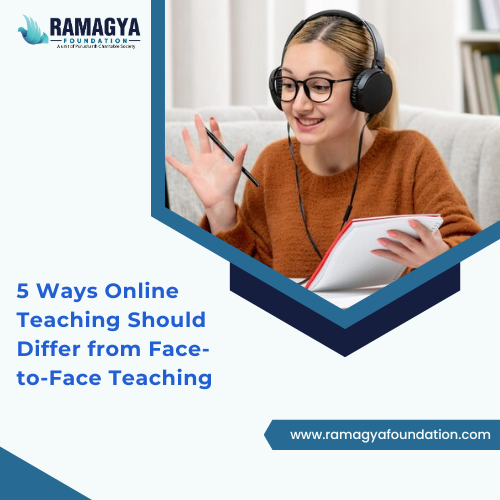In the ever-evolving landscape of education, the transition from traditional face-to-face teaching to online learning has become more than just a trend-it’s a transformative force. As the Ramagya Foundation continues its mission to provide accessible education for the underprivileged, it’s crucial to acknowledge that online teaching should not simply replicate the traditional classroom. Today, we will delve into five fundamental ways online teaching should differentiate itself from the traditional face-to-face teaching model, ensuring students receive the best learning experience.
1. Student-Centered Learning: Personalization and Flexibility
One of the most significant advantages of online teaching is the opportunity to embrace student-centered learning fully. In traditional classroom settings, the one-size-fits-all approach is standard, with educators delivering content to a group of students who may have diverse learning needs. However, online teaching allows for a more personalized and flexible instructional approach.
Here’s how online teaching can differentiate itself through student-centered learning:
-
- Self-Paced Learning: Online platforms often allow students to progress independently. They can review content, complete assignments, and take assessments according to their unique learning speed.
- Adaptive Learning Tools: Adaptive learning software and platforms can assess students’ progress and adapt the content to suit their needs. If a student struggles with a particular concept, the system can provide additional resources or exercises to reinforce their understanding.
- Individualized Support: Online teachers can offer one-on-one support, addressing each student’s challenges and providing guidance accordingly.
- Independent Exploration: Online resources encourage students to explore and learn independently, fostering a sense of ownership over their education.
2. Embracing Technology as a Resource
Online teaching should not merely incorporate technology; it should wholeheartedly embrace it as a valuable resource. Educational technology offers many resources, including multimedia content, interactive simulations, and collaborative tools to enhance the learning experience. Recognizing that technology is not a replacement for teachers but a powerful tool that can enhance the learning process is essential.
Here are a few ways in which online teaching can leverage technology effectively:
- Multimedia Content: Online courses can incorporate multimedia elements such as videos, animations, and interactive simulations to make learning more engaging and accessible.
- Collaborative Platforms: Virtual platforms enable students to collaborate on projects, fostering teamwork and problem-solving skills.
- Online Libraries and Resources: The internet is a vast source of information, and online teaching can utilize digital libraries and resources to provide students with a wide range of reference materials.
- Real-World Applications: Technology can connect students’ learning to real-world applications, making education more relevant and practical.
3. Enhanced Interactivity: Leveraging the Digital Realm
Online teaching should prioritize interactivity in ways unique to the digital environment. While traditional face-to-face teaching relies heavily on verbal communication and physical presence, online teaching can offer additional channels for interaction. Using discussion boards, chatrooms, and virtual classrooms enables students to engage in meaningful dialogues, collaborate on projects, and seek peer assistance.
The online teaching environment allows for various forms of interaction, such as:
- Discussion Forums
- Live Video Conferencing
- Peer Collaboration
- Immediate Feedback
4. Flexibility and Accessibility: Reaching Diverse Audience
One of the standout advantages of online teaching is its flexibility for educators and students. Lessons can be accessed anytime, allowing students to balance their studies with other commitments.
The flexibility and accessibility of online teaching can be achieved through:
- 24/7 Accessibility
- Self-Paced Learning
- Reduced Travel Time
- Reaching Remote Areas
5. Comprehensive Assessment Methods: Beyond Traditional Testing
Online teaching should employ diverse and comprehensive assessment methods. While traditional exams and quizzes can be a part of the evaluation process, online teaching opens the door to more innovative assessment forms. Educators can use tools like online portfolios, peer reviews, and real-world projects to gauge student understanding and application of knowledge.
Here’s how online teaching can differentiate itself through comprehensive assessment methods:
- Online Portfolios: Students can create digital portfolios that showcase their work, progress, and achievements throughout the course.
- Peer Reviews: Students can assess each other’s work, fostering critical thinking and constructive feedback.
- Real-World Projects: Assignments can be designed to mirror real-world scenarios, allowing students to apply their knowledge to practical situations.
- Continuous Assessment: Online teaching can adopt a continuous assessment model, where student performance is evaluated regularly throughout the course.
Adapting for a Digital World
Online teaching should be seen as something other than a replication of face-to-face teaching but as an adaptation to a digital world. By centering the learning experience on students, embracing technology as a resource, enhancing interactivity, offering flexibility and accessibility, and employing comprehensive assessment methods, online teaching can become a powerful tool for providing quality education to all.
As the Ramagya Foundation strives to empower the underprivileged through education, the distinctiveness of online teaching allows us to reach those who might otherwise be left behind. By harnessing the potential of digital education and recognizing its unique strengths, we can create a more inclusive and accessible learning environment that fosters the growth and development of all students, regardless of their circumstances. Online teaching is not a mere extension of the traditional classroom; it’s a portal to a more flexible, interactive, and personalized learning experience that can benefit students from all walks of life.
